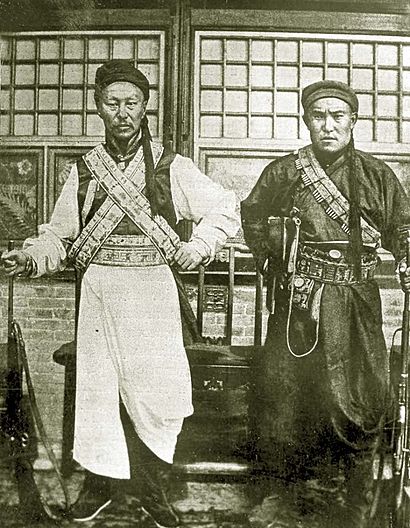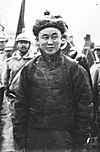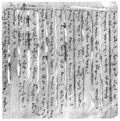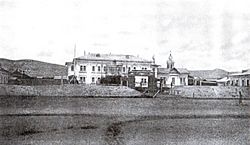Mongolian Revolution of 1911 facts for kids
Quick facts for kids Mongolian Revolution of 1911 |
||||
|---|---|---|---|---|
| Part of the 1911 Revolution | ||||

Anti-Chinese commanders Togtokh and Bayar in Khüree (now Ulaanbaatar)
|
||||
| Date | April 1910 – 29 December 1911 | |||
| Location | ||||
| Caused by |
|
|||
| Goals | Independence of Mongolia | |||
| Resulted in | Partial nationalist victory:
|
|||
| Parties to the civil conflict | ||||
|
|
||||
| Lead figures | ||||
|
||||
The Mongolian Revolution of 1911 (Mongolian: Үндэсний эрх чөлөөний хувьсгал, ᠦᠨᠳᠦᠰᠦᠨ ᠦ, ᠡᠷᠬᠡ, ᠥᠥᠯᠥ᠋ᠥ, ᠬᠣ᠊ᠪᠢᠰᠠᠠᠠᠯᠨᠢᠢ᠋, romanized: Ündèsnij èrx čölöönij xuv’sgal) was a major event in Mongolia's history. It happened when the region of Outer Mongolia decided to become independent from the Qing dynasty. The Qing dynasty was led by the Manchu people in China. This revolution was part of a larger movement called the Xinhai Revolution in China.
Many people in China were unhappy with the Qing government. This was due to money problems and the government's failure to stop Western countries from taking over parts of China. When the Qing government planned to move many Han Chinese people into Mongolia and make Mongols more like Han Chinese, the Mongols resisted. This led to a mostly peaceful separation from the Qing Empire. Many leaders from the Barga and Inner Mongolian groups helped in this revolution.
Contents
Why the Revolution Happened
By the early 1900s, Mongolia was very poor. This was partly because of a big rebellion in China called the Taiping Rebellion (1850–1864). This rebellion cost the Qing government a lot of money. They also lost tax money from southern China.
Because of this, the Qing government started asking Mongols to pay taxes in silver instead of livestock. Mongols often had to borrow silver from Han Chinese merchants. These loans had very high interest rates. Mongols had to pay back these loans with their livestock, which was then sent to China. This caused a huge drop in the number of animals Mongols owned. This was a big problem because Mongols depended on their herds for their way of life.
Mongolia's economy was failing, debt was growing, and taxes were increasing. These problems caused social and political unrest. But the main reason for the rebellion was the Qing government's plans to change Outer Mongolia.
The "New Administration" Plan
The Qing dynasty (1636–1912) was started by the Manchu people. They were not Han Chinese. Earlier, the Qing rulers had laws to keep Manchuria, China, and Mongolia separate. For example, Han Chinese were not allowed to enter Mongolia. Mongols were also not allowed to leave their own areas. They were forbidden from speaking Chinese or marrying Han Chinese. Over time, these rules were not strictly followed, but they were still in place.
In the late 1800s, Western countries started to take more control in China. China's defeat by Japan in 1895 (First Sino-Japanese War) and other events showed that the Qing government was weak. After Japan won against Russia in 1905 (Russo-Japanese War), many in China believed that a modern government was better than an old-fashioned one. So, the Qing government started big changes called the "New Administration" or "New Policies" (Xin zheng). These changes were meant to modernize China.
However, in Outer Mongolia, the "New Administration" was different. Its goal was not just to modernize, but to make Mongols more like Han Chinese. Russia had taken over parts of Manchuria, which made the Qing government worried. They feared Russia wanted to control their northern border. The Qing rulers thought that for China to survive, its border regions needed to be strong. To do this, they believed the people in these regions needed to become Chinese.
Between 1901 and 1910, the Qing government started a large plan. They wanted to move Chinese people to the border areas and change how local governments worked. A new rule in 1910 removed the old bans on Chinese settling in Outer Mongolia. It also allowed Chinese and Mongols to marry and Mongols to use the Chinese language. This was the final step in breaking down the separation that the Manchu rulers had created centuries ago.
In early 1910, the Qing government sent Sando to Urga (now Ulaanbaatar), the capital of Mongolia. Sando was a Mongol himself. His job was to put the "New Administration" into action. He quickly set up twenty offices to manage things like the army, taxes, police, and trade. There were also plans to bring Chinese farmers to Mongolia. In January 1911, a Chinese officer arrived to organize a Mongolian army. Half of this army was supposed to be Mongolian herdsmen. A large barracks was built near Urga.
Mongolians saw these changes as a threat to their way of life. They sent a message to the Qing government saying: "Among the many rules, not one helps the Mongolians. We all want to live according to our old ways." The Chinese officers were also very arrogant and harsh, which made things worse.
Mongolian Resistance Begins
Soon after Sando arrived, a fight broke out between some lamas (Buddhist priests) and Chinese people in Urga. In the past, Qing officials would quickly stop such fights. But this time was different. When Sando went to Gandan Monastery, the main monastery, to arrest people, the lamas threw stones at him and his soldiers. Sando and his troops had to leave.
Sando then demanded that the Jebstundamba Khutuktu, the spiritual leader of the Mongols, hand over a lama who was thought to be the leader of the incident. The Khutuktu refused, and Sando fined him. In response, the Mongols asked the Qing government to remove Sando, but they were not successful.
Other problems followed, showing that Sando's power was weakening. A minor noble named Togtokh Taij and his small group robbed several Chinese merchant shops in eastern Mongolia. Local Mongolian officials helped him. Sando sent soldiers to catch Togtokh, but the Mongolian guide led them into a trap, and most were killed. Mongolian princes also refused to provide soldiers for Sando's army. A prince whose area Togtokh had raided also refused to pay money to the robbed Chinese merchants.
The Decision for Independence
By the spring of 1911, some important Mongolian nobles, like Prince Tögs-Ochiryn Namnansüren, convinced the Jebstundamba Khutukhtu to hold a meeting. They wanted to discuss becoming independent. The Khutukhtu agreed. To avoid suspicion, they said the meeting was for a religious festival. They claimed they would discuss how to share taxes among different areas.
The meeting happened on July 10. The Mongols debated whether to obey or resist the Qing government. They couldn't agree. Some wanted full resistance, others only partial. So, eighteen nobles secretly met outside Urga. They decided that Mongolia must declare its independence. They then convinced the Khutuktu to send three important people to Russia to ask for help. These three were a noble, a religious leader, and a common official from Inner Mongolia. This mix of people showed that many different groups supported the mission.
The group went to St. Petersburg, Russia. They carried a letter signed by the Khutuktu and the "four khans of Khalkha" (Mongolian leaders). The letter asked for help against the Chinese, including weapons. It also suggested that Russian troops might be needed. To get Russia's help, the Mongols promised economic benefits. The letter was not clear about what kind of relationship Mongolia wanted with Russia.
Russia wanted Outer Mongolia to be in its sphere of influence. This meant Russia wanted to have a lot of control there. Russia also wanted Mongolia to be a buffer state, a safe zone between Russia and China and Japan. But Russia never planned to make Mongolia part of its own empire. The Russian government decided to support Mongolia's independence, but only as an independent region within the Qing empire, not a fully separate country. They would use diplomacy, not military force. However, Russia did send more guards to its consulate in Urga to protect the returning Mongolian group.
The Russian minister in Beijing then told the Qing government that the Mongols had complained to Russia about Chinese immigration, military build-up, and changes to their government. He warned that Russia was concerned and that China would face problems if it ignored this warning.
Mongolia Becomes Independent
When the Qing government heard about the Mongolian mission to Russia, they told Sando to investigate. Sando immediately called the head of the Khutukhtu's religious administration and demanded an explanation. The religious leader said he was not involved but told Sando the whole plan. Sando then demanded that the Khutuktu take back his request for Russian troops. The Khutuktu agreed, but only if Sando stopped the "New Administration" changes. Sando asked Beijing for instructions and was told that some parts of the "New Administration" could be delayed.
Sando ordered the princes in Urga to sign a statement saying that only a few people were responsible for asking Russia for help. The princes agreed, but only verbally. Sando then told the Mongols not to talk to the Russian consulate anymore. He threatened to bring 500 more troops to Urga and arm the Chinese people in the city if they disobeyed. He placed guards around the Khutuktu's palace to stop Russian visitors. He also sent soldiers to the Russian-Mongolian border to stop the Mongolian group returning from Russia.
Meanwhile, big changes were happening in China. On October 10, there was an uprising in Wuchang, and a revolution against the Qing rulers began. One Chinese province after another declared itself independent from the Qing government. Sando felt he could not stay in his position. He asked Beijing for permission to resign, but his request was denied.
At the same time, the Mongolian group secretly returned from Russia. They told a group of princes and lamas what had happened. They then asked the Khutukhtu what Mongolia should do, given the uprisings in China. He advised that Mongols should form their own state.
With the Khutuktu's support and the Qing dynasty falling apart, the Provisional Government of Khalkha was formed. It was led by important Khalkha nobles. On November 28, the government ordered all four provinces of Khalkha to prepare a thousand soldiers each. Almost immediately, 500 men from nearby areas gathered in Urga.
Two days later, Sando received a letter from the nobles and lamas of Khalkha. It said they had heard about the revolution in China. It also said that Chinese "revolutionary party" troops were planning to march on Urga from Inner Mongolia. The letter claimed that the Khutuktu had ordered 4000 troops to go to Beijing to defend the Emperor. Sando was asked to provide food and weapons for these men. He was given three hours to reply, but no reply came.
The Mongols then dropped their trick. A group of nobles and lamas visited Sando's office. They told him they had decided to declare independence and make the Khutuktu their emperor. Sando begged them not to. He admitted his mistakes and promised to recommend full self-rule for Mongolia, but not full independence. The Mongols simply said they were there to deliver a message, not to discuss it. Sando was ordered to leave the country within 24 hours.
Sando could do little. He only had 150 soldiers, and they were unhappy because they hadn't been paid. The next day, Mongolian soldiers and Russian Cossacks from the consulate took away Sando's soldiers' weapons. Sando and his staff moved into the Russian consulate for safety.
On November 30, 1911, the Mongols set up the Temporary Government of Khalkha. On December 5, Sando left Mongolia with a Russian escort. Chinese power in the rest of the country quickly disappeared. Later that month or in January 1912, the Chinese military governor in Uliastai, western Mongolia, and his staff left peacefully with Russian protection. However, the deputy military governor of Khovd decided to fight. He hoped for more soldiers from Xinjiang. But the help came too late. Mongolian troops surrounded the town, and the Chinese reinforcements were defeated. In August 1912, Mongolian troops took over Khovd. The governor and his staff were then escorted out of the country by Cossacks.
On December 1, the Provisional Government of Khalkha announced that Qing rule was over. They declared that a new government, led by the Jebtsundamba Khutuktu, was established. At the end of December, on December 29, the Khutuktu was officially made the Bodg Khaan ("Great Khan" or "Emperor") of the new Mongolian state. This began the Bogd Khan era. Many Mongolian groups, including Barga, Dariganga, and others from Inner and Upper Mongolia, sent messages supporting the Bogd Khan's idea of a united Mongolia. However, most of them were too careful or unsure to actually join the new Bogd Khan government.
The Mongolian revolution was mostly a peaceful transfer of power. This was because the Qing officials in Mongolia were realistic. Also, Russian troops were present, protecting these officials and Chinese soldiers. The situation was different in Inner Mongolia. There, Chinese officials stayed in power, even though some Mongols wanted to join Outer Mongolia in independence.
Russia's Role
Russia's role in this revolution has been debated. Chinese historians often say that Russia caused and controlled the events of 1911. However, documents from Russia and Mongolia do not support this idea. The desire for independence in Outer Mongolia was mainly a reaction to the Qing government's new policies. These policies aimed to make Mongols more like Han Chinese.
The Russian government wanted Outer Mongolia to be a buffer state. This would protect Russia's borders in Siberia from Chinese and Japanese influence. Russia saw Mongolia as a dependent state or a self-governing part of China. The revolution also showed a growing sense of nationalism among Mongols. They wanted to form their own nation, similar to what was happening in China at the time.
Key Leaders of the Revolution
- Tögs-Ochiryn Namnansüren - A leader from Outer Mongolia.
- Da Lam Tserenchimed - A leader from Outer Mongolia.
- Eighth Jebtsundamba Khutugtu - The spiritual leader and later Emperor of Outer Mongolia.
- Jalkhanz Khutagt Sodnomyn Damdinbazar - A leader from Outer Mongolia.
- Mijiddorjiin Khanddorj - A leader from Outer Mongolia.
- Manlaibaatar Damdinsüren - A military leader from Barga Mongolia.
- Khatanbaatar Magsarjav - A military leader from Outer Mongolia.
- Bayantömöriin Khaisan - A leader from Inner Mongolia.
- Togtokh Taij - A chieftain from Inner Mongolia who fought against the Chinese.
- Sumiya beis - A Chahar chieftain from the Ili region. He came to Mongolia with 271 people.
- Hurleg beis - A representative from Upper Mongols.
- Udai van - A leader from Inner Mongolia. He wrote the Eastern Mongolian Declaration of Independence in 1913.
- Bavuujav - A Harchin chieftain from Inner Mongolia. He fought against the Chinese until 1915.
See also
 In Spanish: Revolución mongola de 1911 para niños
In Spanish: Revolución mongola de 1911 para niños
- Xinhai Revolution - The revolution in China that happened at the same time.
- Mongolian Revolution of 1921 - A later revolution that changed Mongolia from a religious monarchy to a communist state.
- Mongolian Revolution of 1990 - A more recent revolution that changed Mongolia from communism to democracy.
- Mongolia under Qing rule - How Mongolia was governed by the Qing dynasty before the revolution.
- Bogd Khanate of Mongolia - The new state formed after the 1911 revolution.
- Occupation of Mongolia - A period when Mongolia was occupied by other powers.
- Independence Day (Mongolia) - The day Mongolia celebrates its independence.









